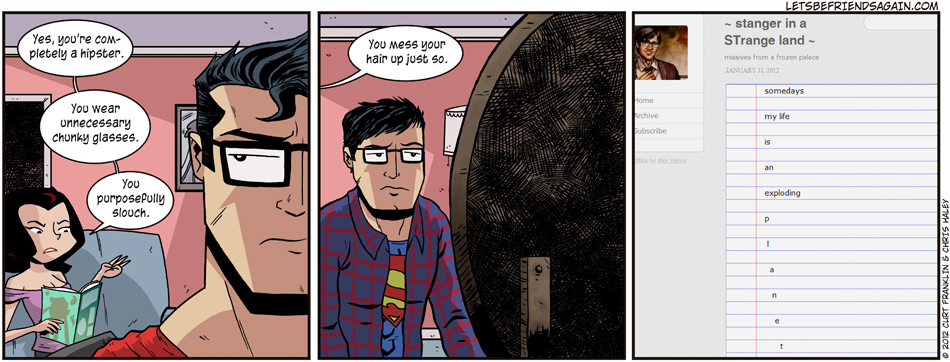“Tell me, Doctor, where are we going this time? Is this the 50’s… or 1999?”
business and economy, comics and animation, computers, dining and cuisine, event, everyday glory, family and friends, games, geekery, history, LEGO and Rokenbok, movies and TV, politics and law, science and technology, the world, Whiskey Tango Foxtrot...?! February 2nd, 2012Thursday – 02 February 2012
It’s not just another NBN Thursday, it’s also Groundhog Day.
Yep. It’s just like that. And, apparently, the groundhog predicts six more weeks of winter. (Apparently, Utah never gets that memo.)
Last night was Movie Date Night around the household. The movie I chose was Drive, as SaraRules! and I both have an affinity for car chase movies. It was good… and far from what I expected, which was a pleasant surprise. I can’t really say “how” or “why”, but I will say this: The movie is not for the squeamish.
After the movie, I played a little CoD: Modern Warfare 3. There was one round that was horrid. Seriously abominable. The team we faced locked my team down on a map and just ate us up. We’d respawn. We’d die. Lather. Rinse. Repeat. Fortunately (or “mercifully”), the round was over fairly quickly.
Chew on This: Food for Thought – Black History Month
Today’s person of note is Benjamin Banneker.
Benjamin Banneker (November 9, 1731 – October 9, 1806) was a free African American astronomer, mathematician, surveyor, almanac author and farmer.
It is difficult to verify much of Benjamin Banneker’s family history. Some writers have stated that he was a grandson of a European American named Molly Welsh, who came to colonial America as an indentured servant.Researchers have questioned this, as Banneker described himself only as having an African ancestry. None of Banneker’s surviving papers describe a white ancestor or identify the name of his grandmother.
Born on November 9, 1731 near Elliott City, Maryland, Benjamin Banneker was educated by Quakers, however, most of his education was self-taught. He quickly revealed to the world his inventive nature and first achieved national acclaim for his scientific work in the 1791 survey of the Federal Territory (now Washington, D.C.).
Benjamin Banneker has been called the first African American intellectual; because of his dark skin and great intellect he was called the “sable genius.” Benjamin Banneker was a self-taught mathematician and astronomer. In 1753, after studying the inner workings of a friend’s watch, he made a wooden pocket watch – one of the first watches made in America – that accurately kept time for more than 40 years. Twenty years later, Banneker began making astronomical calculations that enabled him to successfully forecast a 1789 solar eclipse.
From 1791 to 1802, he published the Pennsylvania, Delaware, Maryland, and Virginia Almanac and Ephemeris, which contained tide tables, future eclipses, and medicinal formulas. It is believed to be the first scientific book published by an African American. Also a surveyor, Banneker was appointed by President George Washington to the District of Columbia Commission, which was responsible for the survey work that established the city’s original boundaries. When the chairman of the committee, Pierre Charles L’Enfant, suddenly resigned and left, taking the plans with him, Banneker reproduced the plans from memory, saving valuable time. A staunch opponent of slavery, Banneker sent a copy of his first almanac to then-Secretary of State Thomas Jefferson to counter Jefferson’s belief in the intellectual inferiority of blacks.
On August 19 1791, Banneker sent a copy of his first almanac to secretary of state Thomas Jefferson. In an enclosed letter, he questioned the slaveholder’s sincerity as a “friend to liberty.” He urged Jefferson to help get rid of “absurd and false ideas” that one race is superior to another. He wished Jefferson’s sentiments to be the same as his, that “one Universal Father . . . afforded us all the same sensations and endowed us all with the same faculties.” Jefferson responded with praise for Banneker’s accomplishments.
Banneker never married. Because of declining sales, his last almanac was published in 1797. After selling much of his farm to the Ellicotts and others, he died in his log cabin nine years later on October 9, 1806, exactly one month before his 75th birthday. A commemorative obelisk that the Maryland Bicentennial Commission and the State Commission on Afro American History and Culture erected in 1977 stands near his unmarked grave in an Oella, Maryland, churchyard.
- A Guide to Pairing Your Comics & Beer
The only thing I’d change would be the Superman entry… to Budweiser. - Sandia Labs engineers create ‘self-guided’ bullet, courtesy of everydave
- LEGO ‘Back to the Future’ Town Should Be Turned Into an Official LEGO Line
- Achievement Unlocked!

- WordPress attacks try to infect users with dangerous rootkit
- Pockets of prosperity across USA escaped recession
- Company Banned in Effort to Protect Foreign Students From Exploitation

- From the “Whiskey Tango Foxtrot…?!” file:
- France convicts Google Maps for unfair competition
Namaste.
Leave a Reply
You must be logged in to post a comment.


